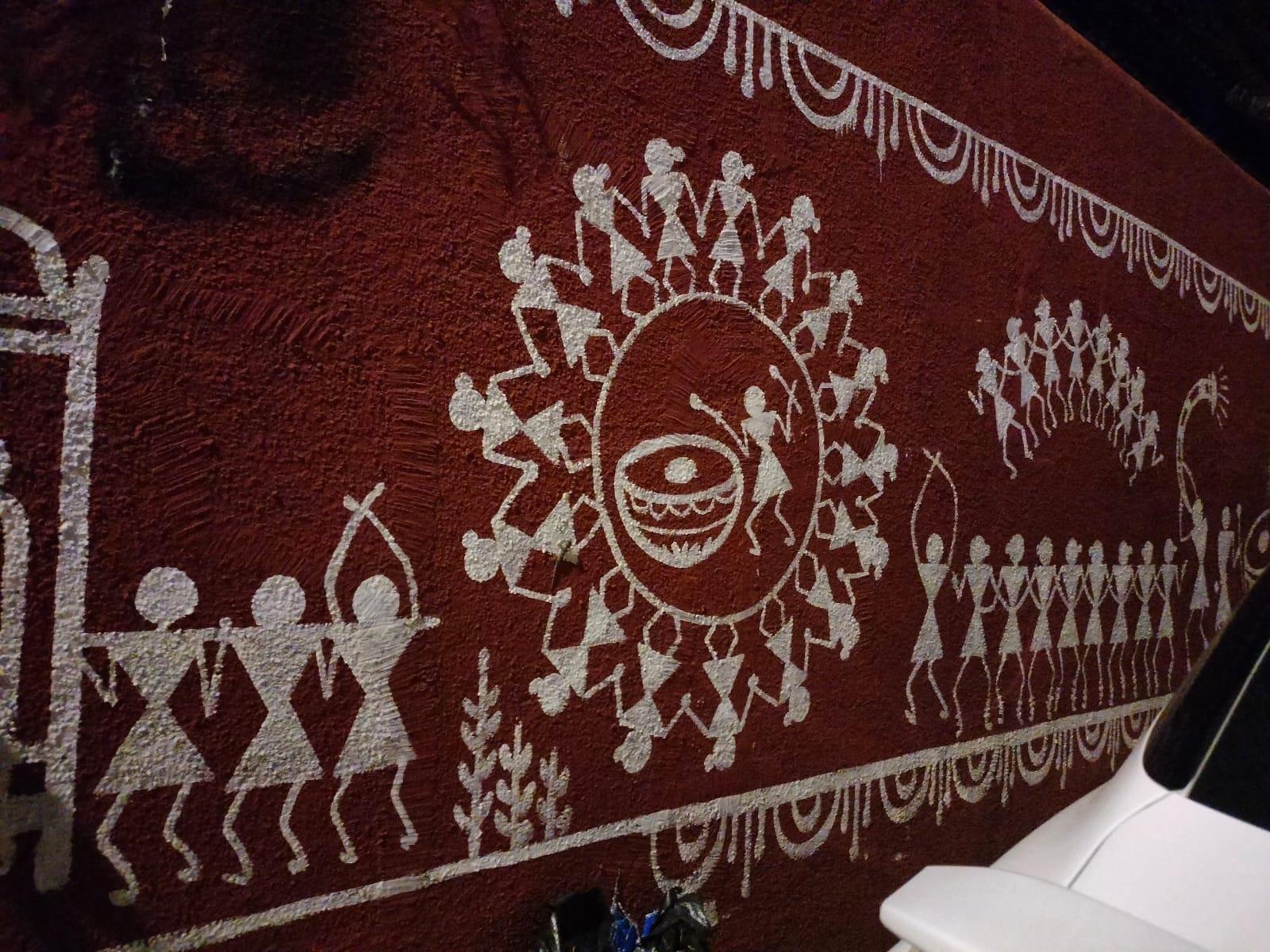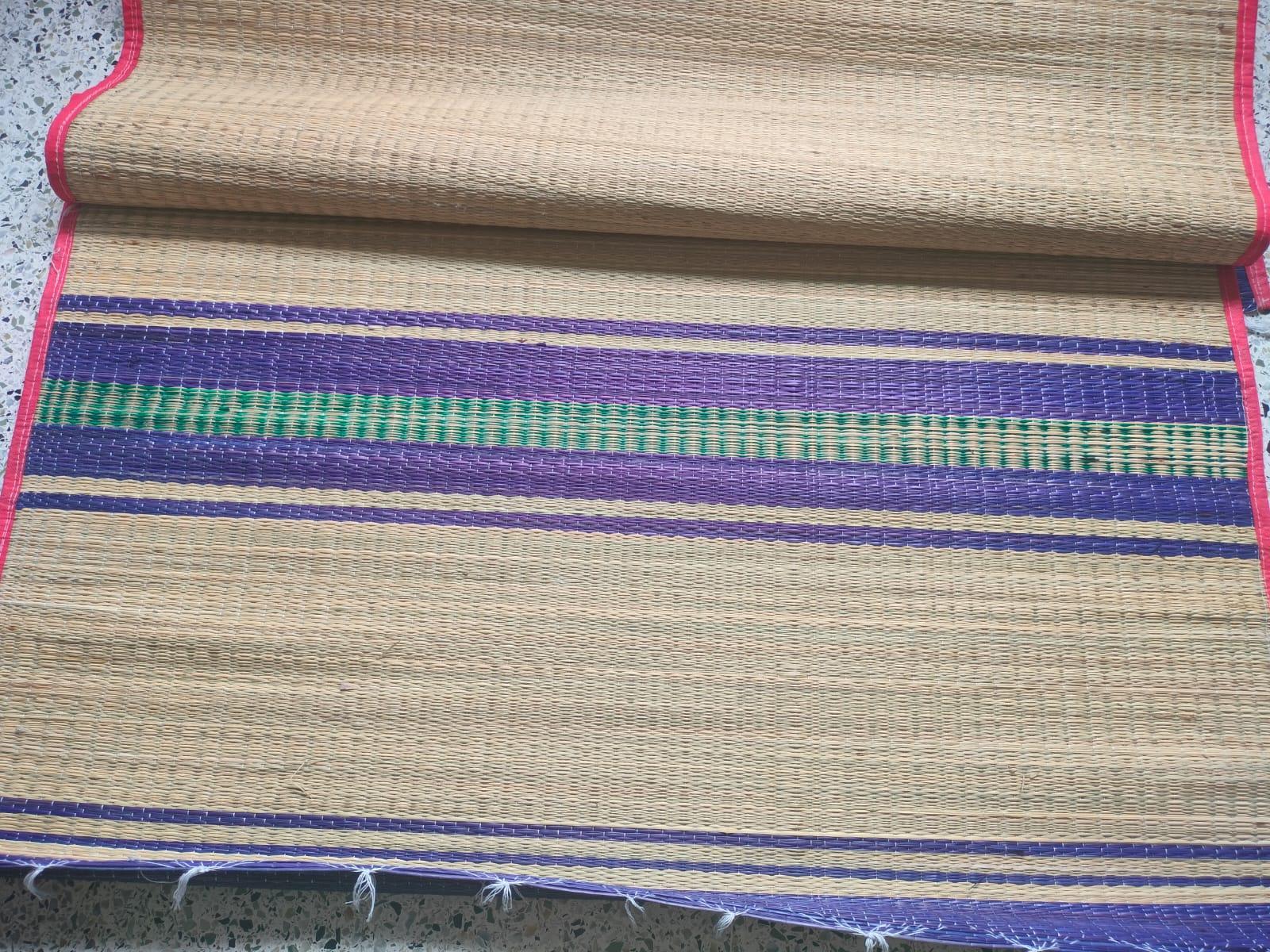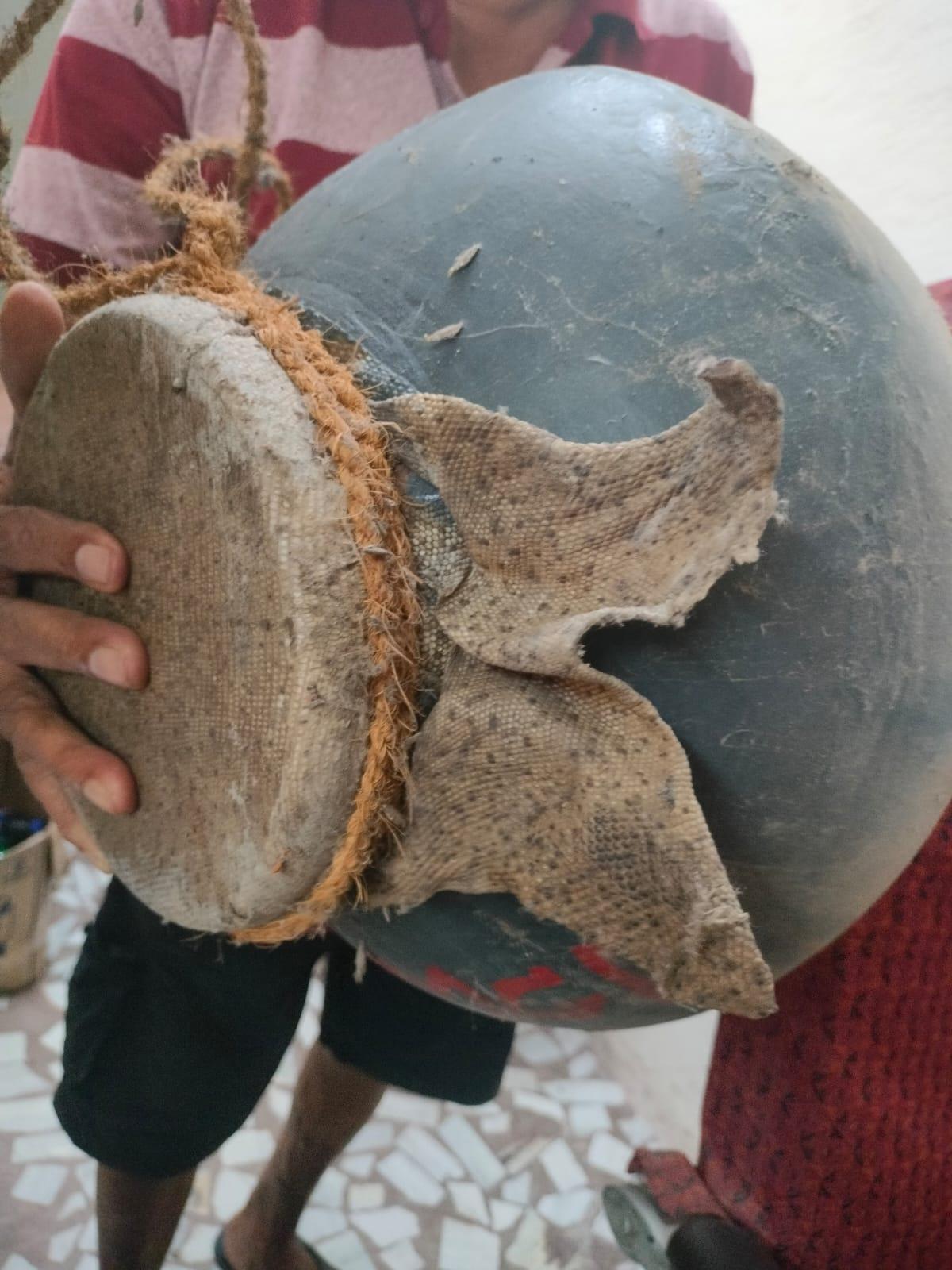MUMBAI SUBURBAN
Artforms
Last updated on 22 July 2025. Help us improve the information on this page by clicking on suggest edits or writing to us.
Literary & Performing Arts
Songa
Songa is a folk theatre tradition performed during Holi, especially in Bhandup Koliwada. It features short plays with music and social messages, popular among the Koli and Agri communities across eastern Mumbai and Navi Mumbai.
Theatre
Theatre in Mumbai has played a major role in shaping modern Indian performance. The city’s theatre culture spans several languages, including Hindi, Marathi, Gujarati, and English. From the mid-20th century onward, especially in the years following independence, Mumbai’s theatre began to engage more directly with social and political themes.
Prithviraj Kapoor emerged as a key figure during this period. His productions, including Deewar (1946) and Ahooti (1949), addressed issues such as displacement and national identity. The founding of Prithvi Theatre in 1978 created a dedicated space for both experimental and commercial work, helping to shape a new era in Indian theatre. Today, Mumbai remains an important centre for theatre, with a mix of large-scale productions, new writing, and independent work contributing to its ongoing presence in the city’s cultural landscape.
Bollywood
Bollywood refers to the Hindi-language film industry based in Mumbai. It is one of the most active film industries globally, known for its high volume of production and its wide distribution network across India and abroad. Though the name itself is a blend of “Bombay” and “Hollywood,” it describes a distinctly local industry shaped by its specific economic, cultural, and spatial context.
The industry’s early base was in South and Central Mumbai, in neighbourhoods like Grant Road and Dadar, where the first theatres and studios were located. By the mid-20th century, limited space and rising costs led to a gradual move northward. Studios opened in Chembur, actors settled in Bandra, and Mehboob Studios was built there in 1954.
Mehboob Studios
Mehboob Studios is a film studio in Bandra, Mumbai. It was started in 1954 by filmmaker Mehboob Khan. The studio served as one of the filming locations for the iconic Mother India (1957), which was nominated for an Academy Award. During the 1950s and 60s, it was common for films to be shot entirely in studios like this one. Mehboob Studios offered all the services needed to make a film in one place.
![Mehboob Studios was one of the filming locations for this iconic film, which became India’s first official nominee for the Academy Award for Best Foreign Language Film.[1]](/media/culture/images/maharashtra/mumbai-suburban/artforms/mehboob-studios-was-one-of-the-filmi_4jzwRLg.png)
As the film industry began shooting more on location and using new technology, studio work became less central. However, Mehboob Studios is still used for film and TV shoots, and remains an important part of Mumbai’s film history.
Film City
This shift deepened in 1977 with the creation of Film City. The suburbs soon became the operational centre of the industry. Film City, also known as Dadasaheb Phalke Chitranagari, is a large film and television production center in Goregaon, Mumbai. It was built by the Maharashtra government in 1977 to support the growing film industry. The complex has indoor studios, outdoor sets, and technical facilities for shooting and editing.
![Established in 1977 by the Maharashtra government in Goregaon, Film City provided the space and infrastructure needed for large-scale film and television production in Mumbai’s expanding suburbs.[2]](/media/culture/images/maharashtra/mumbai-suburban/artforms/established-in-1977-by-the-maharasht_ooteZWw.png)
Film City played a major role in helping the industry move from South Mumbai to the suburbs. It became a hub for both movies and television shows. Today, it is one of the busiest film production areas in India.
Dubbing
Dubbing is a significant part of Mumbai’s film and television industry, supporting both domestic productions and the localization of foreign content. It involves replacing or supplementing dialogue with recorded voices, either to match a different language or to enhance vocal performance. While actors perform on screen, dubbing artists provide voices that align with the character’s tone, language, or emotional delivery.
![A voice artist records dialogue in a Mumbai studio, matching tone, timing, and expression to the original on-screen performance.[3]](/media/culture/images/maharashtra/mumbai-suburban/artforms/a-voice-artist-records-dialogue-in-a_sfpxxqP.png)
Mumbai serves as a major centre for dubbing in India, with dedicated studios, voice artists, and sound engineers operating across the city. Andheri, in particular, has become a hub for this work, with studios such as Sound & Vision Studio and Aradhana Sound Service leading the field since the late 1980s and 1990s. These facilities are used for dubbing international films into Indian languages, as well as for replacing original voice tracks in domestic productions when required.
Dubbing artist Deepak Sinha, who began his career as a radio announcer, has worked across multiple genres and formats. He has voiced characters such as Hawkeye in the Hindi version of Marvel films and Bijjaladeva in Baahubali. Sinha notes the dual challenges of the profession: “Your voice has to suit the character while also syncing perfectly with the actor’s performance.”
![A veteran dubbing artist, Deepak Sinha has lent his voice to a wide range of characters, including Hawkeye in the Hindi version of Marvel films and Bijjaladeva in the Hindi-dubbed Baahubali.[4]](/media/culture/images/maharashtra/mumbai-suburban/artforms/a-veteran-dubbing-artist-deepak-sinh_lii62Rr.jpg)
There are two primary types of dubbing in the industry: one where voice artists substitute for on-screen actors, and another where content is adapted into different languages. In both cases, the process requires careful attention to timing, tone, and expression. As the demand for multilingual content has grown—particularly with the rise of streaming platforms—the role of dubbing has expanded.
Dubbing is also used to localize films across India’s many linguistic regions. Hindi-dubbed versions of South Indian films, and Tamil or Telugu versions of Hollywood films, have contributed to the growing reach of both regional and international cinema. According to Sinha, the field has become more professional over time, with structured casting processes and increasing technical precision.
In this context, dubbing is not only a technical process but also a form of performance. Artists are trained to control pitch, inflection, and timing, and often use distinct vocal registers for different characters. Sinha describes five primary voice placements, stomach, chest, throat, nasal, and skull tones, each suited to a particular emotional or physical type.
Several voice artists, including Shakti Singh, Sharad Kelkar, Mona Ghosh Shetty, and Leela Roy Ghosh, have played key roles in shaping the industry. Their work has helped make dubbed content accessible across languages, expanding the audience for Indian and international films alike.
Warli Art
Warli art is a traditional visual style practiced by the Warli community, an indigenous group primarily located in the northern regions of Maharashtra and parts of Gujarat. Characterised by the use of simple geometric forms, such as circles, triangles, and lines, Warli paintings depict scenes from daily life, nature, and community rituals. Common subjects include farming, wildlife, festivals, and traditional dances, often arranged in rhythmic compositions that emphasize movement and interconnectedness.
The art form is traditionally created using white pigment made from rice paste, applied to mud walls or stone surfaces. Though it is difficult to date precisely, Warli painting is considered one of India’s oldest surviving art forms. Laurence Rose notes in her book Leopard Rising, "Warli art can be traced back 1100 years, and according to art historian Yashodhara Dalmia, it may even continue a tradition dating from the Mesolithic period.”

Artist Jivya Soma Mashe is widely credited with bringing Warli art into public attention in the late 20th century. He described the form as a visual language through which the Warli people document and express their worldview. “Our history is not written, it is drawn,” he stated in reference to the community’s non-textual mode of storytelling. So what is it that led to this idyllic artform filled with life and joy to hold within it images of violence, budding encroachments, and threats in Mumbai?
In 2014, the Mumbai Metro Rail Corporation Limited (MMRCL) announced its plan to construct a metro car shed in Aarey, a forested area home to many indigenous communities. The project proposed the clearing of nearly 75 acres of land and the removal of over 2,000 trees. News of this prompted resistance. As citizens, environmentalists, and local residents came together under the banner of the Save Aarey movement, a familiar form began to appear in unfamiliar ways: Warli paintings, not as ritual or record, but as protest.
Artist Shital Bhoir was one of many who turned to this tradition to express what was unfolding around her. In her work, traditional pastoral Warli imagery of humans, trees, and animals now shared space with concrete roads, bulldozers, and encroaching cityscapes. What once showed harmonious village life now captured a landscape under pressure. Her art visualised a conflict not just over land, but over meaning, what the forest represents, and who has the right to speak for it.
![Shital Bhoir’s reinterpretation of Warli art places construction equipment, felled trees, and forest creatures side by side, documenting the impact of urban development on the life of indigenous communities in Aarey.[5]](/media/culture/images/maharashtra/mumbai-suburban/artforms/shital-bhoirs-reinterpretation-of-wa_uIKzBU6.png)
The tension between forest and city is not new in Mumbai, but Aarey has made it visible. For generations, Adivasi communities have lived within and alongside these forests, even as the city expanded around them. Urban development continues to move outward, often at the cost of those who have lived most closely with the land. Warli art became a way to hold on to that relationship.
![A still from the music video Warli Revolt by Swadesi Movement and Prakash Bhoir. The animation incorporates traditional Warli iconography to voice opposition to deforestation and displacement.Artwork byDinesh Barap and animation byJanmeet Singh.[6]](/media/culture/images/maharashtra/mumbai-suburban/artforms/a-still-from-the-music-video-warli-r_VWIaTsD.png)
Mushroom Art
Mushroom art is a distinctive practice among some Adivasi artists in Aarey, who use dried mushrooms from the forest as natural canvases. These small, organic surfaces are hand-painted with traditional Warli motifs carefully rendered in white pigment.
![Hand-painted Warli designs on dried mushrooms collected from the forest. Each piece reflects the artist’s connection to the land and the everyday life of the community.[7]](/media/culture/images/maharashtra/mumbai-suburban/artforms/hand-painted-warli-designs-on-dried-_GTfFx8q.png)
Hand Weaved Bamboo Mats

Bamboo mat weaving is a traditional craft once widely practiced in Mumbai, particularly for producing mats used in everyday domestic life. Before the introduction of plastic-based household goods, locals say that these mats were commonly found in homes across the city. They remained prevalent in suburban markets through the 1960s and 1970s. The craft, many say, was closely associated with Muslim artisans, many of whom operated small shops near dargahs.
Cultural Programs
Prithvi Festival
Prithvi Theatre, established in Mumbai and named after actor Prithviraj Kapoor, has played a central role in the city’s theatre culture. The Prithvi Festival was launched in 1983 to mark the theatre’s anniversary on November 5.
![Prithvi Theatre during the annual Prithvi Festival, held every November since 1983 to mark the theatre’s anniversary.[8]](/media/culture/images/maharashtra/mumbai-suburban/artforms/prithvi-theatre-during-the-annual-pr_th5BLpQ.png)
Held annually, the festival has become a major cultural event, featuring a range of performances including contemporary productions, reinterpretations of classic plays, and original works. It typically runs for around 10 days in November and serves as a platform for dialogue between artists, critics, and audiences.
Creative Spaces of the District
NMACC
The Nita Mukesh Ambani Cultural Centre is a multi-disciplinary arts venue located in Mumbai. Established by Nita Ambani, the centre hosts performances, exhibitions, screenings, and discussions across various genres
![Nita Mukesh Ambani Cultural Centre in Bandra, Mumbai, a multi-purpose arts space opened to showcase performance, visual arts, and cultural programs.[9]](/media/culture/images/maharashtra/mumbai-suburban/artforms/nita-mukesh-ambani-cultural-centre-i_9Gq33hL.png)
It includes flexible spaces equipped with advanced technology for theatre, music, and film. A key feature of the centre is the Art House, a gallery for contemporary visual art. The NMACC promotes cultural exchange and supports a wide range of artistic practices.
Art and Charlie
Art and Charlie is a contemporary gallery located in Pali Village, Bandra. Initially launched as a nomadic curatorial platform, it held exhibitions across multiple sites in Mumbai before establishing a permanent gallery space.
![Exterior view of Art and Charlie gallery in Pali Village, Bandra.[10]](/media/culture/images/maharashtra/mumbai-suburban/artforms/exterior-view-of-art-and-charlie-gal_lpFrzUm.png)
Its exhibitions often focus on themes related to everyday life, urban space, and cultural practice. The gallery also hosts artist talks and small-scale public programs. Art and Charlie is part of a growing network of independent art spaces in Mumbai.
Instruments
Ghumat
The ghumat is a traditional instrument used by the East Indian community in Mumbai. It consists of an earthen base with a membrane traditionally made from wild lizard skin. The instrument is typically played during community events such as weddings, christenings, umbracha paani (a ritual water-fetching ceremony), and other social gatherings.

Today, the possession of ghumats is illegal due to the new animal welfare and protection laws. Due to this clash between traditions and modern values, the fate and continuity of the use of this instrument remains uncertain.
East Indian Bands
Brass bands are an important part of East Indian celebrations, often performing Marathi songs and folk music at community events. These ensembles, band members say, traditionally included instruments such as trumpets, bass drums, and guitars. Bands that once had 14–15 members have now reduced in size, typically operating as six-piece groups.
The tradition is rooted in the introduction of European-style marching bands during British colonial rule. While the musical form has foreign origins, East Indian bands have adapted it to local contexts. Today, they are commonly seen at weddings, processions, competitions, feasts, and other community events
Artists
Dinesh Barap
Dinesh Barap is a Warli artist based in Mumbai. He began painting at a young age, learning from his grandmother, who painted on walls during community events such as weddings and festivals. His early work followed this format, using mud walls as surfaces for traditional motifs.
![Dinesh Barap holding hand-painted royal poinciana seed pods featuring Warli art, created using natural pigments sourced from local plants.[11]](/media/culture/images/maharashtra/mumbai-suburban/artforms/dinesh-barap-holding-hand-painted-ro_Hln1SlH.png)
In recent years, Barap has expanded his practice by experimenting with natural materials as surfaces, including wild kaayri, dried mushrooms, bamboo shoots, and rocks. He also makes his own pigments using eco-friendly sources such as leaves, flowers, rice flour, and fruit peels. His palette includes natural reds from junglee abuli flowers, yellows from ringdi, greens from leaves, and ochres from ripe mangoes.
Barap’s work has been exhibited in public spaces and in collaboration with non-governmental organizations. He creates painted items such as jute bags and keychains and has worked with groups like the Committed Communities Development Trust. He also co-leads the Dahisar River Walks with photographer Aslam Saiyad, combining art and environmental education.
Gulzar
![Gulzar, known for his contributions to Indian cinema, Urdu poetry, and Hindi film lyrics.[12]](/media/culture/images/maharashtra/mumbai-suburban/artforms/gulzar-known-for-his-contributions-t_sIOEZv4.png)
Gulzar is a poet, lyricist, and screenwriter known for his work in Indian cinema and literature. Born in present-day Pakistan, he has lived in Bandra, Mumbai, for much of his life. His lyrics, written primarily in Urdu, have been featured in a wide range of Hindi films.
His notable works include songs such as “Aap Ki Ankhon Mein Kuch” from Ghar and “Tere Bina Zindagi Se” from Anand, as well as lyrics for films like Mausam and Masoom. He has also published poetry and short stories and is widely regarded for his ability to bring literary depth to popular music.
Sources
Adivasi Lives Matter. 2020. Warli Painting on Natural Mushrooms ft Shital Borahade | #AdivasiAwaaz. Youtube.https://www.youtube.com/hashtag/adivasiawaaz
Anna Morcom. 2007. Hindi Film Songs and the Cinema. Ashgate Publishing Company.
Anurag. ‘Bhandup Koliwada’. Jio Institute Exhibits.https://exhibits.jioinstitute.edu.in/spotlig…
Art and Charlie. Homepage.https://artandcharlie.com/
Festivals from India. ‘Prithvi Festival’.https://www.festivalsfromindia.com/festival/…
Hallu Hallu. 2021. ‘24th October – Dahisar River Walk’. WordPress.https://gohalluhallu.wordpress.com/2021/10/1…
Inga Garriock. 2016. Telling stories and drawing life – Indian Warli Community projects at the V&A Museum of Childhood. Victoria & Albert Museum Blog.https://www.vam.ac.uk/blog/museum-of-childho…
Khushboo Ali. 2023. ‘Tracing the Legacy of Bandra’s Mehboob Studios.’ Knocksense.https://www.knocksense.com/mumbai/tracing-th…
MasterClass. 2021. ‘What Is Bollywood?’ MasterClass.https://www.masterclass.com/articles/what-is…
Nihit Bhave. 2015. ‘Gulzar on How an 80-Year-Old Urdu Poet Stays Relevant in Bollywood’. Hindustan Times Brunch.https://www.hindustantimes.com/brunch/gulzar…
NMACC. Homepage.https://nmacc.com/
Nolina Minj. 2022. ‘Why the Fight by Adivasis Against a Mumbai Metro Carshed Is a Fight for Survival’. Scroll.in.https://scroll.in/article/1034239/why-the-fi…
Sabah Virani. 2023. ‘Lives, Livelihoods, and Art: What Keeps Warlis Rooted in SGNP’. Citizen Matters.https://citizenmatters.in/lives-livelihoods-…
Sankhayan Ghosh. 2022. ‘Mapping Seven Decades of Mumbai’s Film Industry’. Film Companion.https://www.filmcompanion.in/features/mappin…
Sayantani Nath. 2019. Warli Art on Dried Mushrooms? Peek Inside a Unique Tribal Hamlet in Mumbai’s Aarey. The Better India.https://thebetterindia.com/201937/mumbai-mus…
Swadesi Movement. 2019. The Warli Revolt ft Prakash Bhoir | Swadesi | Azadi Records (AZR012). YouTube.https://www.youtube.com/watch?v=sYADNgIkelY
The Better India. 2019. ‘Mumbai Mushrooms: Paintings That Save Aarey’.https://thebetterindia.com/201937/mumbai-mus…
Last updated on 22 July 2025. Help us improve the information on this page by clicking on suggest edits or writing to us.